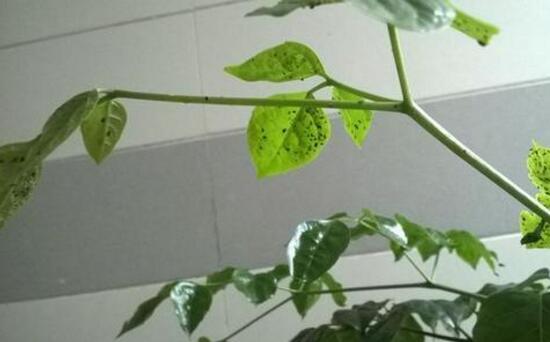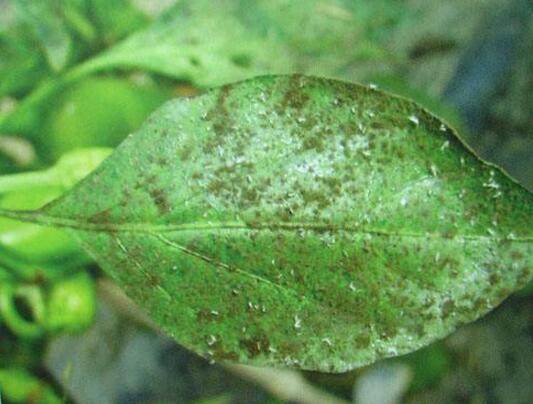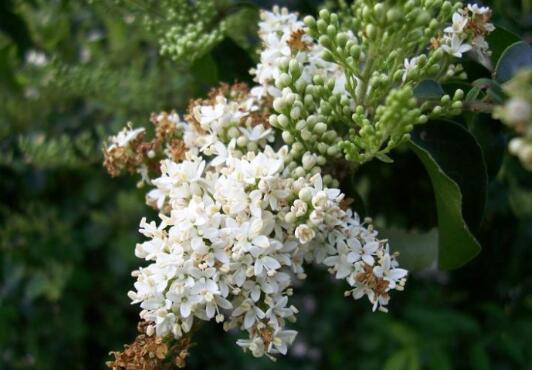Happy tree long insects how to do, happy tree pest control/3 pests 3 diseases
As a kind of plant with good meaning and beautiful meaning, the happiness tree is welcomed and loved by the majority of flower friends and is potted at home by many people. However, due to improper maintenance and other reasons, the happiness tree will grow insects and get sick, thus seriously affecting its ornamental ability, so what if the happiness tree grows insects? The following is the pest control of the happiness tree selected by the editor. Go in and have a look!
What if the happiness tree grows worms? spray.

Happiness tree is a common indoor potted plant with strong plant type and emerald green leaves. However, indoor is not compared to outdoor, once we do not follow the happiness tree breeding method, it will have problems, resulting in long worms to get sick. As for what to do when the happiness tree grows worms, it is very simple to find out which kind of worm it is, and then spray it with the corresponding medicine. The diseases and insect pests of Happiness Tree mainly include 3 insect pests and 3 diseases. Let's move on.
II. Pest control of Happiness Tree
1. Scale insects
Under the premise of high temperature, high humidity and poor ventilation, shell insects are easy to appear on the stems and leaves of Happy trees. Symptoms of being violated: the leaves of the happiness tree yellowed, withered, and even fell, seriously affecting the indoor ornamental effect of the happiness tree.
Prevention and control methods: a small number of shell insects can be wiped off with a wet cloth in real time, or they can be glued off with transparent tape; when diseases and pests are frequent, they can be sprayed in turn with 50% marathon and 40% dimethoate 0.1% solution.
2. Mites
One of the diseases and insect pests of Happiness Tree, which usually occurs from June to September. High temperature and dryness are conducive to the occurrence of large numbers of mites. Symptoms of being infringed: the new leaves of the happiness tree are wrinkled and curled, and the leaves are not obedient.
Control methods: the pest is mainly sprayed with chemicals, and acaricidal agents such as Dabaxin and Nisolang are preferred.
3. Aphids
An insect that invades the happiness tree, it parasites on the leaves, absorbs juice, and mainly harms young leaves and stems. Symptoms of being violated: the leaves of Happiness Tree are wrinkled and deformed. Aphids can be seen with the naked eye, once they appear, they are dense and look very scary.
Control methods: when there are a small number of aphids, you can kill them manually, such as picking with needles or brushing them off with tools such as a brush; when there are many aphids, spray them with zinc parathion, omethoate, enemy kill, etc.
4. Powdery mildew
Powdery mildew of Happy Tree is a kind of fungal disease, which occurs frequently and mainly harms leaves, stems, flower buds and other parts. Disease symptoms: small white powder spots appear in the diseased leaves, and the above will also be covered with white powdery mildew layer, affecting the ornamental nature of the happy tree, making the plant short and lifeless.
Prevention and cure method: when the disease is mild, wipe off the white powder on the surface of the leaf, and then place it in a ventilated environment; when the condition is serious, trim the branches of seriously diseased plants properly, and spray the 800-fold solution of 29% azine, once every 7-10 days, you can recover after a few times.
5. Leaf spot
One of the main diseases of Happiness Tree is that in the environment of high temperature, high humidity and poor ventilation, the leaves of Happiness Tree are easily infected with leaf spot disease. Symptoms of illness: the happiness tree has yellow leaves, spots on the leaves, withered branches and other symptoms.
Prevention and treatment: find a small number of diseased leaves, remove and burn them in time to reduce the source of the disease, and then spray 50% carbendazim wettable powder 600 times, once every half a month, 3 times each time, and it will be effective after a few times.
6. Coal pollution disease
One of the diseases and insect pests of Happy Tree, it is a fungal virus, the disease occurs in summer and autumn, mainly harms the leaves and branches of the plant. Symptoms: dark brown mildew spots appear on the surface of happy leaves, which will expand into a black soot-like fog layer over time, causing the leaves to fall off.
Prevention and treatment: if we want to prevent and cure the disease, we should reduce the degree of air wetness, ventilation and replenish light. Then spray the drug stone sulfur mixture on the surface of the leaves, wait for the leaves to absorb the medicine, and then clean the leaves with clean water.
There are bugs flying on the flowers and trees raised at home
"there are a lot of flying insects in the gentleman's orchid basin at home. What's going on? what should I do?" Yesterday, Ms. Zhang, a citizen, posted a Wechat message on moments for help. Our city landscape engineer Yang Xiuqin tips: domestic flowers and trees encounter aphids and other attacks, can be sprayed with insecticides, and place ventilation.
The reporter saw in Wechat moments that Ms. Zhang, a citizen, said that recently, the magnolia, which was raised on the balcony at home, had a large number of small black flying insects in the basin, which not only stayed on the basin soil, but also flew around all over the balcony, which was very annoying. Mr. Zhong, a citizen, also said that the happiness tree, which he has kept at home for two years, has been growing well in the past, but recently he has also suffered from insect pests, with some white floc on the branches and waxy spots on the leaves.
In this regard, the reporter consulted Yang Xiuqin, a landscape engineer in our city.
Yang Xiuqin told reporters that the current plum rain season, the weather is humid, but also a high incidence of flowers and trees and insect pests. She analyzed that the small flying insects in Ms. Zhang's magnolia pot are called aphids, which is a common flower and tree pest and one of the most destructive pests.
"as for the happiness tree of Mr. Zhong's family, it is the shell bug that is making fun of it." Yang Gong said that shell insects are the most common pests in flowers and fruit trees, and their secretions can also cause coal fouling disease and do great harm.
Yang Xiuqin says that the easiest way for citizens to get rid of aphids at home is to use sprays bought in supermarkets to kill cockroaches, mosquitoes and flies, and enemies, and spray them directly on bugs. It should be reminded that these pesticides should be diluted at a ratio of 1 to 1000 to prevent excessive concentrations from burning flowers and trees. Experts say this method is also effective for other common red spiders, thorns and other pests.
Yang Xiuqin told reporters that because the secretions of flowers and trees that have suffered from the disease are waxy, it is not easy to kill them with the above-mentioned insecticides. Therefore, citizens can gently wipe the diseased plants with alcohol or vinegar to get rid of the insects. Yang Gong said that if there are not many damaged branches and leaves, the public can also directly cut off insect branches and leaves. What needs to be reminded is that in the end, the branches and leaves of these diseases should be burned together, and do not litter.
Finally, Yang Xiuqin says that pest prevention is more important than cure. First of all, members of the public should try their best to put flowers and trees in places with good ventilation and adequate light. Second, to keep flowers and pots clean and hygienic, try not to pour waste milk, bean curd and other residues into the basin. Third, it is necessary to frequently trim the branches and leaves of flowers and trees, properly thinning the branches of plants that are too dense, so that they can be ventilated and visible, and properly placed in the open air in the rain.
Try insecticide spraying on flowers and trees at home
China Garden Network on June 30 news: "at home in the gentleman orchid basin, there are a lot of flying insects, what is the matter, what should I do?" Yesterday, Ms. Zhang, a citizen, posted a Wechat message on moments for help. Our city landscape engineer Yang Xiuqin tips: domestic flowers and trees encounter aphids and other attacks, can be sprayed with insecticides, and place ventilation.
The reporter saw in Wechat moments that Ms. Zhang, a citizen, said that recently, the magnolia, which was raised on the balcony at home, had a large number of small black flying insects in the basin, which not only stayed on the basin soil, but also flew around all over the balcony, which was very annoying. Mr. Zhong, a citizen, also said that the happiness tree, which he has kept at home for two years, has been growing well in the past, but recently he has also suffered from insect pests, with some white floc on the branches and waxy spots on the leaves.
In this regard, the reporter consulted Yang Xiuqin, a landscape engineer in our city.
Yang Xiuqin told reporters that the current plum rain season, the weather is humid, but also a high incidence of flowers and trees and insect pests. She analyzed that the small flying insects in Ms. Zhang's magnolia pot are called aphids, which is a common flower and tree pest and one of the most destructive pests.
"as for the happiness tree of Mr. Zhong's family, it is the shell bug that is making fun of it." Yang Gong said that shell insects are the most common pests in flowers and fruit trees, and their secretions can also cause coal fouling disease and do great harm.
Yang Xiuqin says that the easiest way for citizens to get rid of aphids at home is to use sprays bought in supermarkets to kill cockroaches, mosquitoes and flies, and enemies, and spray them directly on bugs. It should be reminded that these pesticides should be diluted at a ratio of 1 to 1000 to prevent excessive concentrations from burning flowers and trees. Experts say this method is also effective for other common red spiders, thorns and other pests.
Yang Xiuqin told reporters that because the secretions of flowers and trees that have suffered from the disease are waxy, it is not easy to kill them with the above-mentioned insecticides. Therefore, citizens can gently wipe the diseased plants with alcohol or vinegar to get rid of the insects. Yang Gong said that if there are not many damaged branches and leaves, the public can also directly cut off insect branches and leaves. What needs to be reminded is that in the end, the branches and leaves of these diseases should be burned together, and do not litter.
Finally, Yang Xiuqin says that pest prevention is more important than cure. First of all, members of the public should try their best to put flowers and trees in places with good ventilation and adequate light. Second, to keep flowers and pots clean and hygienic, try not to pour waste milk, bean curd and other residues into the basin. Third, it is necessary to frequently trim the branches and leaves of flowers and trees, properly thinning the branches of plants that are too dense, so that they can be ventilated and visible, and properly placed in the open air in the rain.
- Prev

What about the long bugs of peppermint flowers? pest control of mint flowers / 2 insect pests 2 diseases
In the process of cultivating peppermint, what people are most afraid of is the situation of diseases and insect pests, because many people do not know much about this kind of situation, so they are often at a loss when they appear. What about the long bugs of peppermint? what do you need to do to prevent and control peppermint diseases and insect pests? It is described in detail below.
- Next

Is the lobular privet poisonous? can the lobular privet be cultivated indoors / non-toxic can be raised indoors?
Lobular Ligustrum lucidum is a common flower plant in people's life, which has high ornamental value, and it is precisely because of this that many people want to keep one at home, but now many plants on the market are toxic to a certain extent. So before we breed, we need to find out about whether lobular privet is poisonous.
Related
- Fuxing push coffee new agricultural production and marketing class: lack of small-scale processing plants
- Jujube rice field leisure farm deep ploughing Yilan for five years to create a space for organic food and play
- Nongyu Farm-A trial of organic papaya for brave women with advanced technology
- Four points for attention in the prevention and control of diseases and insect pests of edible fungi
- How to add nutrient solution to Edible Fungi
- Is there any good way to control edible fungus mites?
- Open Inoculation Technology of Edible Fungi
- Is there any clever way to use fertilizer for edible fungus in winter?
- What agents are used to kill the pathogens of edible fungi in the mushroom shed?
- Rapid drying of Edible Fungi

